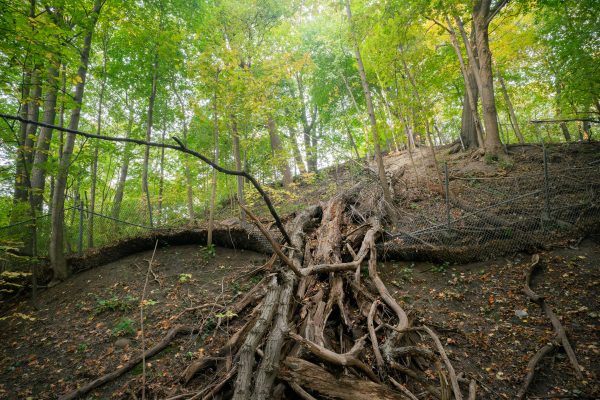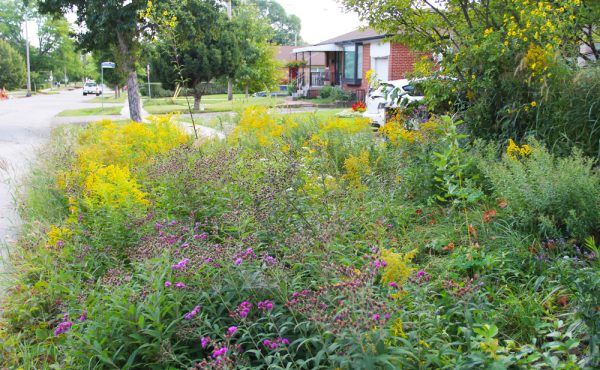Moore Avenue is a small but busy street in North Toronto that usually has a steady line of cars moving in both directions. But for the second time in less than a year, the road has been narrowed to a single lane at the crosswalk where pedestrians and cyclists leave the Mount Pleasant Cemetery and begin their descent into the Mud Creek ravine.
In April, pylons and caution tape festooned what had become a major drop in the pavement that threatened to bottom out cars. The sidewalk that flanked it was cracked into pieces. By May 1st, the entire road was closed for repairs. But no matter how often the city repairs that stretch of Moore, the end result always seems to be the same: water washes out the sediment below the road and eventually the pavement above cracks and sinks.
This is because Mud Creek runs buried under the cemetery and Moore Avenue and only resurfaces on the south side of the street, where it carves a path down through the ravine all the way to the Evergreen Brick Works.
It is frustrating to wait idling in line while the cars take turns passing by the sinkhole, but I can’t help but marvel at the power of the water to stop traffic and once again ruin the city engineers’ plans to build a smooth road over it.
Water goes where water wants to go. You can build all the houses you like on a buried creek or a forgotten floodplain, but the water will remember its ancient route even if you do not, as the 30 people who died on Raymore Drive during Hurricane Hazel, in October, 1954, learned too late. We forget this at our peril.
WATER IS NOT PASSIVE
I grew up on the edge of a ravine and had a constant fear that we were going to slide into it.
This fear was not entirely unreasonable: the plaster ceiling in our living room actually caved in one night because the corner of our house was “travelling south”—as one contractor put it—at a rate of one centimetre each year, sinking down into the ravine.
Ravines are notoriously unstable places. Water falls into them, following gravity, pulling trees and soil down. Pavement cracks at their edges. They are mountain slopes turned upside down.
In the age of the Anthropocene, it’s tempting to think of land and water as something so fragile it needs our protection. There is, of course, truth to this: human beings have become a major, if not geological, force, which puts us in the peculiar position of trying to protect the land and water we depend on from ourselves. But it is also true that land and water are not passive objects that we simply act upon; they are the original agents of geological change, and they have always shaped the way we live just as much as we shape them.
It can be easy to forget this truth when you live in a city. We build our homes and offices mostly wherever we want and we lay down hardpacked roads and bridges that rarely fail. We have cars and buses and streetcars and bicycles to carry us quickly across the city. So it’s easy to feel immune to the power of the environment we live in. It’s almost possible to believe that we live in a world of our own making, one that is rational and predictable and mostly under our control.
Years ago, I encountered an observation that Margaret Atwood had made, describing the city world above the ravines as “the conscious life of electrified houses” and suggesting that going down into the ravines was like “going down into sleep.” It was a moment of recognition for me: I’d always felt the ravines were a mostly unnoticed, unseen force in the city, directing our movements and in some ways controlling our lives—while most of us went about our business above, in the conscious city, hardly aware of them or their power. Moreover, the ravines were also dumping grounds, places where we hid the things we wished to forget: from abandoned shopping carts to runoff from the sewers and the many pollutants that were entering into the water system from the city above.
After mulling this idea over for years—and observing and writing about the city’s ravines for decades—I began to search for a new way to capture the mystery and power I felt when I entered the ravines. I knew I wanted to capture something I did not know how to articulate in words so I decided to try photographing the ravines instead of writing about them. I began to take my camera with me whenever I went for a walk.
Someone once said that cameras are instruments that teach us how to see. This is certainly true for me: the more I images I made, the more I began to see in the ravines. I became alive to the minute changes in the colour of the water, the feathery beginnings of a horsetail growing out of a puddle and how the textures of the leaves on the trees changed from seasons to season: from glossy spring to meaty summer to papery fall. I noticed the minute changes in the colours of the earth and the leaves that covered them as they went from wet to dry and wet again, darkening into humus. I began to listen for the water as it rushed through the city storm sewers towards the ravines after a rainfall. I also saw the ways in which water was always grading and re-grading our streets, forcing us to build this way and that, follow its path to the ravine edges.
As the ravine project grew, I decided I would challenge our naturally human-centric viewpoint by prioritizing the land and water around people rather than the people I saw in the ravines. But I knew that I also did not want to try to make images of an `untouched,’ wild landscape (as if there is such a thing!). So there had to be some kind of evidence of human life in each shot, even if that evidence was very subtle: like the evidence of erosion, which is compounded, not just by climate change but also by the invasive fast-growing Norway maples that now out-compete our deep-rooted native species, and the uncanny green of a nutrient overloaded swamp.
And I wanted to capture the ravine as its own being, still becoming: and as an active subject rather than as a passive object that people act upon. So I went back to the same places over and over again to try to capture a place that was constantly transforming itself and constantly in process.
SHADOWLAND, the product of my work, is now a solo art exhibition on display at the Evergreen Brick Works. It features 12 images from the ongoing ravine project printed on rice paper scrolls and hung unprotected from the ceiling. Viewers are challenged to look at the ravine in new ways and from new points of view—first as they see the shadowy images looming through translucent rice paper. And they are involved in the future of the exhibit itself. The care (or not) that people take in moving through the exhibit will determine how quickly the scrolls begin to wear and age over time—as will the environment they are hanging in. It’s an interesting experiment. Several people have asked if I am worried about vandalism, since the gallery space is not guarded by security. I just shrug my shoulders: this, too, is part of the experiment. It will be interesting to see what happens. Can we be trusted to care for a space that depends on our protection? Will we respect what it needs?
Similarly, I am curious what will happen to the sink-hole on Moore Avenue. Will the city repave it again, blindly expecting new results from an experiment that always yields the same outcome? Or will someone finally agree to let the river run where it wants to run?
They say a fool is a person who keeps doing the same thing over and over and expecting different results. Sometimes I think this describes every one of us, as we carry on our business as usual in the conscious city above the ravines, hoping that the ways in which we’ve constricted and provoked our watershed won’t catch up with us, even though it already has.
photo courtesy of Sasha Chapman
Sasha Chapman is a Toronto-based writer, photographer and artist working on a project about cities and their watersheds. The next installment, WHAT THE RIVER CARRIES, explores the Tiber River and what it means to live downstream from Rome’s imperial legacy. SHADOWLAND, a seven-month experiment in images and sound, is on display at the Evergreen Brick Works from May 1 to December 31.



